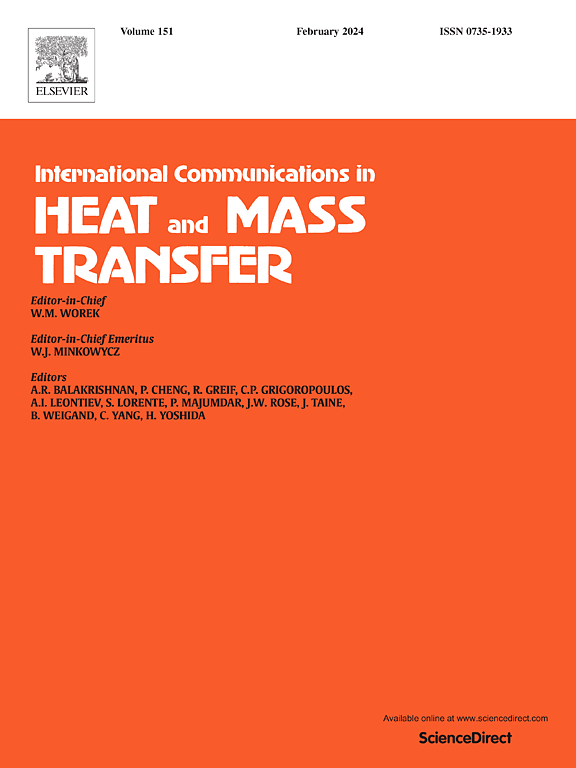采用灵敏度分析、多目标优化与评价的复合方法对仿生翅片-纳米颗粒复合材料换热器的凝固特性进行了研究
IF 6.4
2区 工程技术
Q1 MECHANICS
International Communications in Heat and Mass Transfer
Pub Date : 2025-05-11
DOI:10.1016/j.icheatmasstransfer.2025.109080
引用次数: 0
摘要
研究了纳米颗粒增强仿生鳍对相变材料凝固行为的影响。利用响应面法(RSM)对仿生鳍的设计参数进行了敏感性分析,从而建立了预测相关性。采用非支配排序遗传算法- ii (NSGA-II)、NSGA-III和多目标粒子群算法(MOPSO)等多目标优化算法识别Pareto最优集,确定最优设计变量。此外,将TOPSIS (Order Preference Technique for Similarity to a Ideal Solution)应用于Pareto最优集进行多准则排序,最终确定最优解及其参数。结果表明,基于灵敏度分析,翅片长度和宽度分别对完全凝固时间和传热速率有显著影响。与矩形、树形和单层多孔树形翅片相比,NSGA-III Pareto优化组的换热率分别提高了62.17% ~ 70.13%、32.5% ~ 39%和30.61% ~ 37.02%,完全凝固时间分别缩短了59.87% ~ 60.23%、16.01% ~ 16.76%和15.04% ~ 15.8%。此外,结构优化优于基于纳米颗粒的传热增强,证明了增强导热性和对流协同的有效性。本文章由计算机程序翻译,如有差异,请以英文原文为准。
The solidification characteristics of PCM heat exchangers with bionic fins and nanoparticles for by a compound method of sensitivity analysis, multi-objective optimization and evaluation
This study investigates the influence of an innovative biomimetic fin enhanced with nanoparticles on the solidification behavior of phase change materials. A sensitivity analysis of the biomimetic fin's design parameters was performed using Response Surface Methodology (RSM), leading to the development of a predictive correlation. Multi-objective optimization algorithms, including Non-dominated Sorting Genetic Algorithm-II (NSGA-II), NSGA-III, and Multi-objective Particle Swarm Optimization (MOPSO), were employed to identify Pareto optimal sets and determine the most advantageous design variables. Additionally, the Technique for Order Preference by Similarity to an Ideal Solution (TOPSIS) was applied to the Pareto optimal set for multi-criteria ranking, ultimately identifying the most optimal solution and corresponding parameters. The results indicate that, based on sensitivity analysis, the fin length and width significantly affect the complete solidification time and heat transfer rate, respectively. The NSGA-III Pareto optimal set demonstrated improvements in heat transfer rate ranging from 62.17 % to 70.13 %, 32.5 % to 39 %, and 30.61 % to 37.02 % compared to rectangular, tree-like, and single-layer perforated tree fins, respectively, while reducing complete solidification time by 59.87 % to 60.23 %, 16.01 % to 16.76 %, and 15.04 % to 15.8 %. Moreover, structural optimization outperformed nanoparticle-based heat transfer enhancement, demonstrating the effectiveness of enhanced thermal conductivity and convective synergy.
求助全文
通过发布文献求助,成功后即可免费获取论文全文。
去求助
来源期刊
CiteScore
11.00
自引率
10.00%
发文量
648
审稿时长
32 days
期刊介绍:
International Communications in Heat and Mass Transfer serves as a world forum for the rapid dissemination of new ideas, new measurement techniques, preliminary findings of ongoing investigations, discussions, and criticisms in the field of heat and mass transfer. Two types of manuscript will be considered for publication: communications (short reports of new work or discussions of work which has already been published) and summaries (abstracts of reports, theses or manuscripts which are too long for publication in full). Together with its companion publication, International Journal of Heat and Mass Transfer, with which it shares the same Board of Editors, this journal is read by research workers and engineers throughout the world.

 求助内容:
求助内容: 应助结果提醒方式:
应助结果提醒方式:


